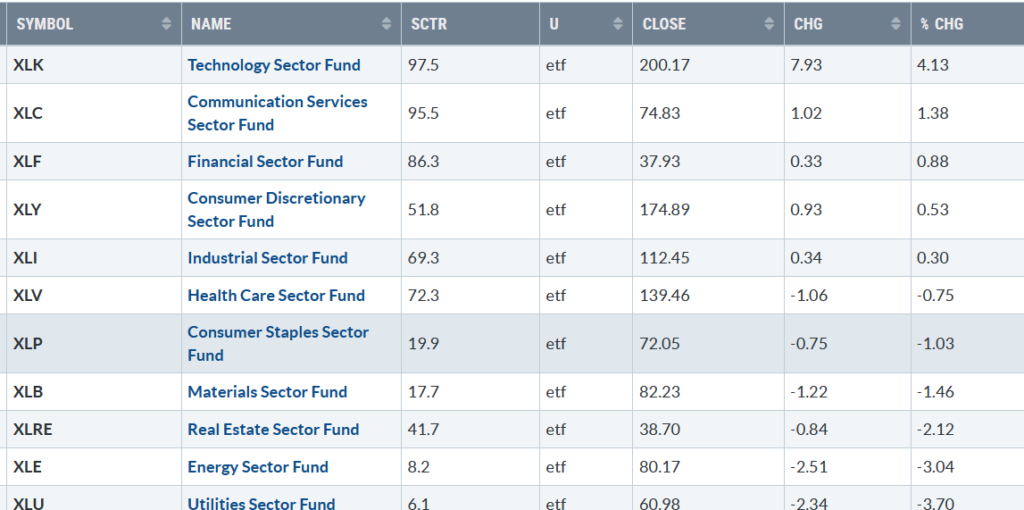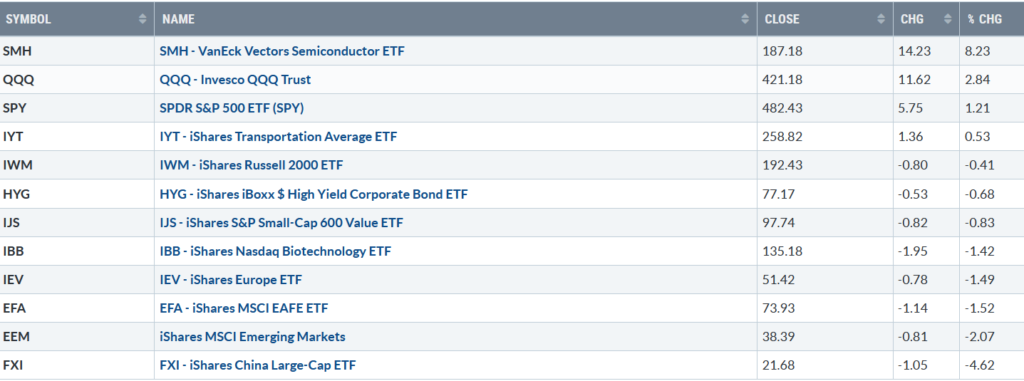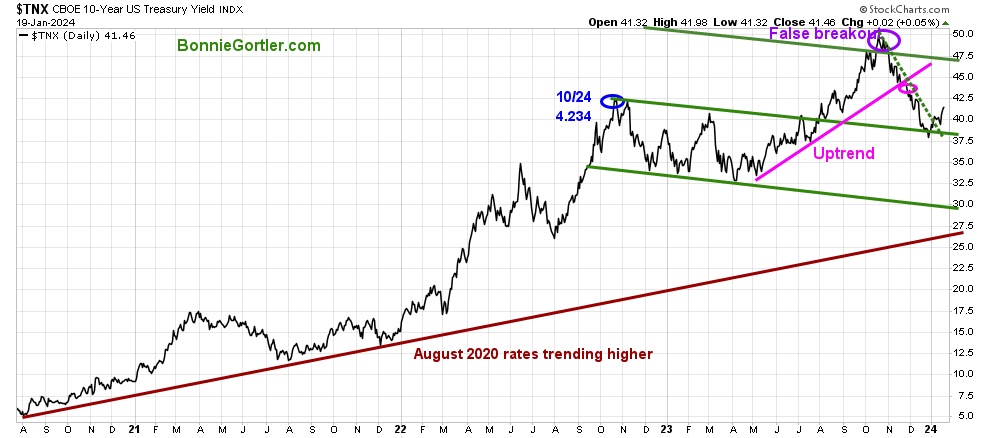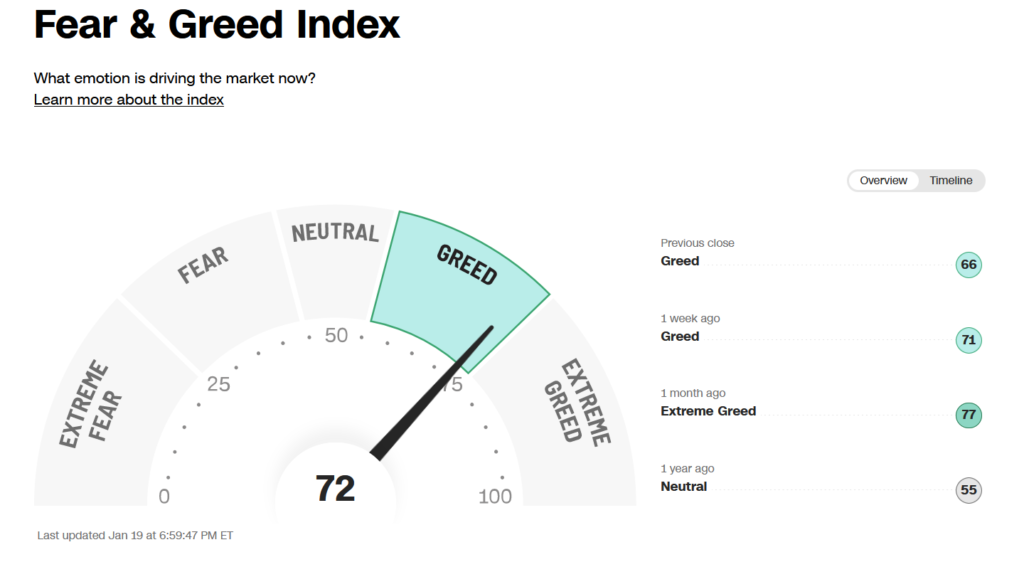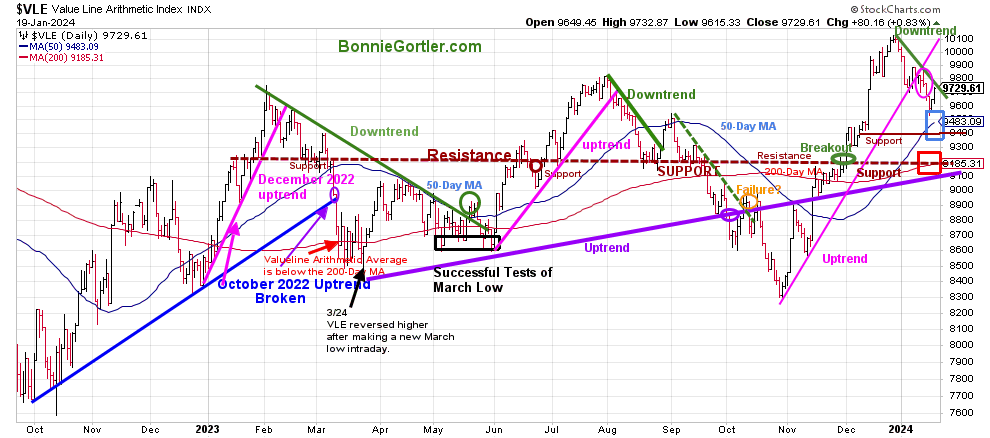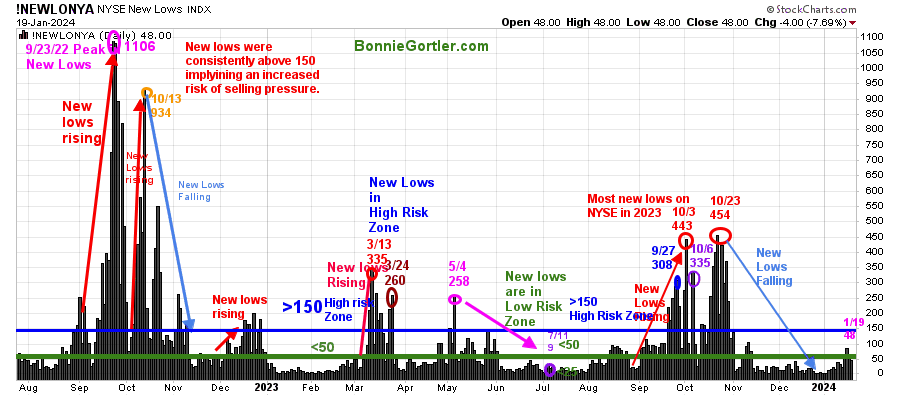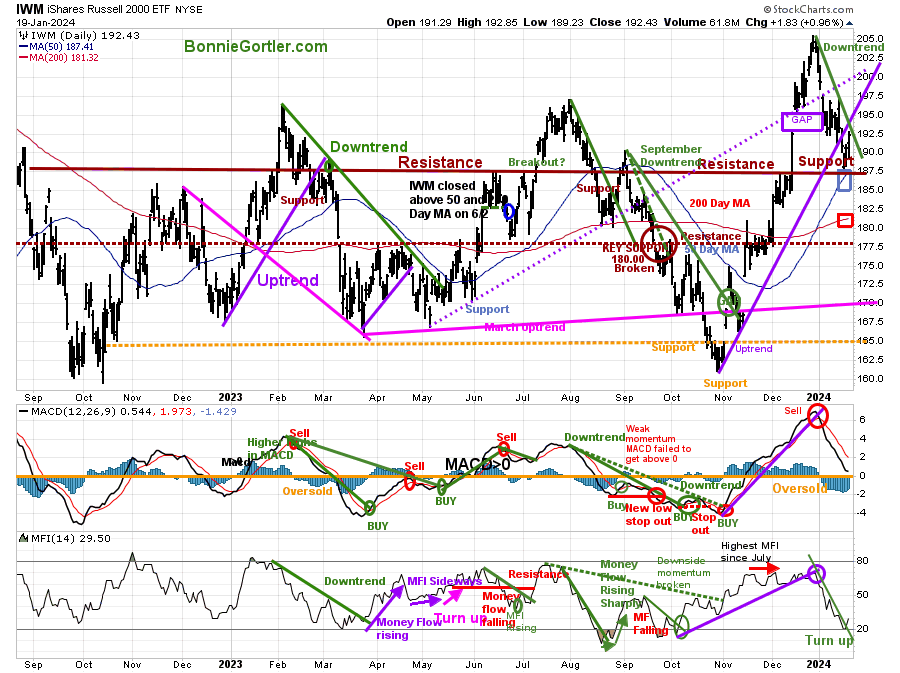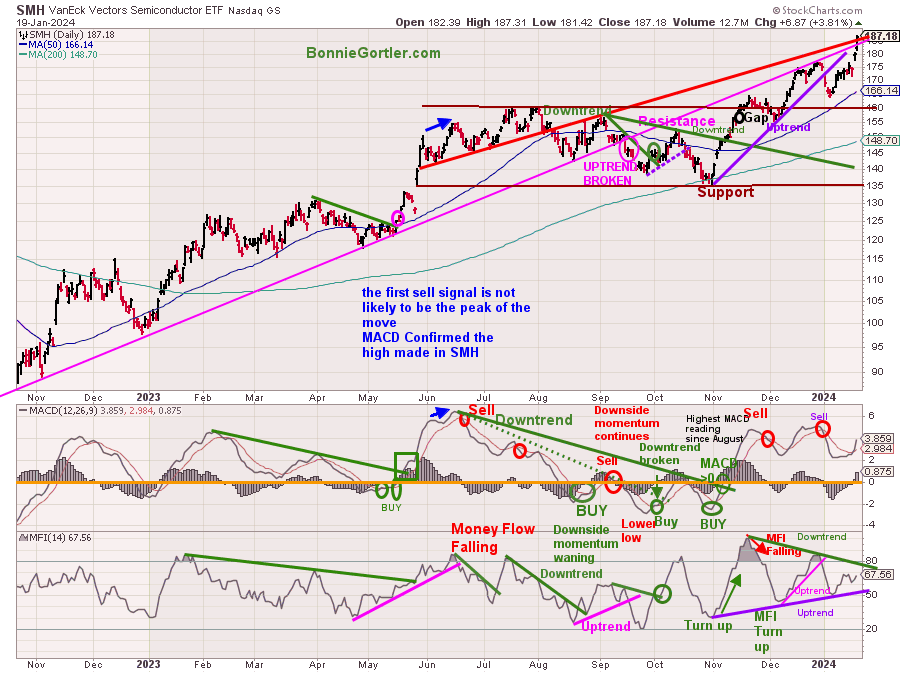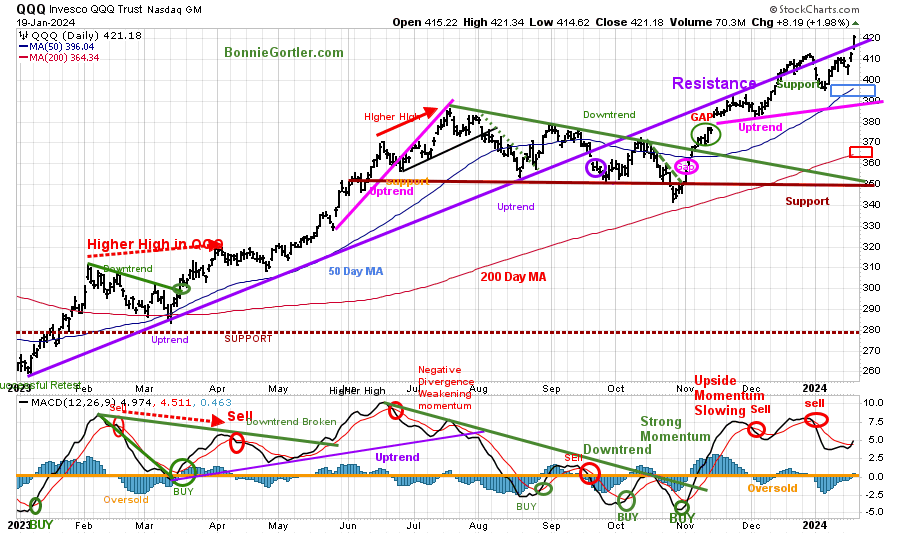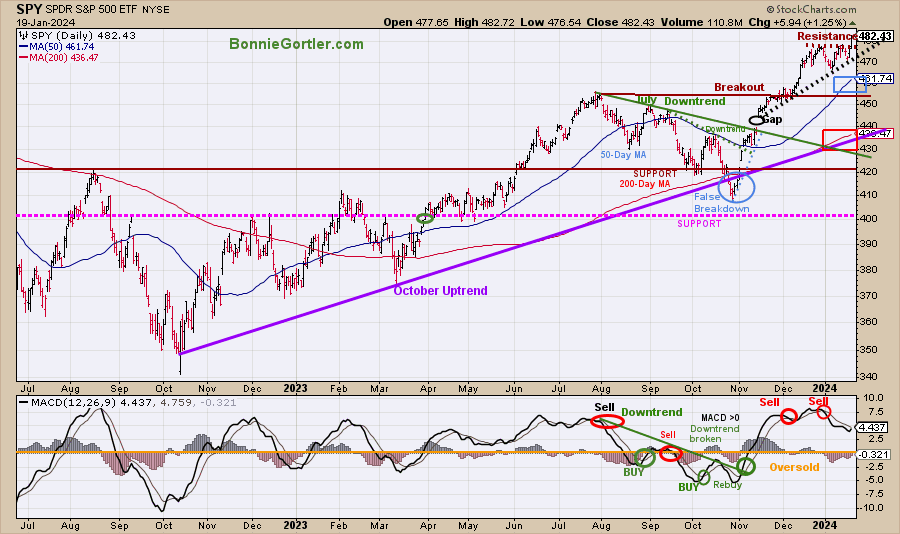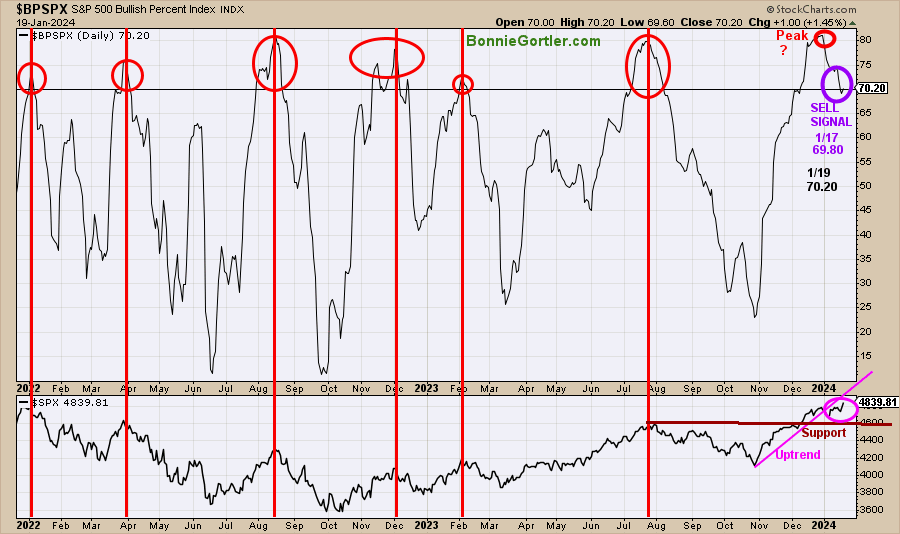Market Update 1/19/24
The advance continues but is not broad-based.
Only five of the eleven S&P SPDR sectors were higher last week. Technology (XLK) and Communication Services (XLC) were the best sectors, while Energy (XLE) and Utilities (XLU) were the weakest. The SPDR S&P 500 ETF Trust (SPY) was up +1.21%.
S&P SPDR Sector ETFs Performance Summary 1/12/24-1/19/24
Source: Stockcharts.com
Figure 2: Bonnie’s ETFs Watch List Performance Summary 1/12/24-1/19/24
Source: Stockcharts.com
Semiconductors and Technology led the market. International markets remain weaker than the U.S., with continued pressure on China.
Figure 3: UST 10YR Bond Yields Daily
The 10-year U.S. Treasury yields rose last week, closing at 4.146, breaking the downtrend line (green dotted) from October. Rising yields could lead to downside pressure in equities.
The major market averages continued to rise. The Dow rose +0.72%, the S&P 500 hit an all-time high up +1.17%, and the Nasdaq up +2.26%. The Russell 2000 Index lagged, down -0.34%.
Figure 4: Fear & Greed Index
Investor sentiment based on the Fear and Greed Index (a contrarian index) measures the market’s mood. The Fear and Greed Index closed at 72, up from 71, still showing greed.
Are you interested in more knowledge about the stock market? Learn how to implement a powerful wealth-building mindset and simple, reliable strategies to help you grow your wealth in my eCourse Wealth Through Investing Made Simple. Learn more here.
Figure 5: Value Line Arithmetic Average
Source: Stockcharts.com
The Value Line Arithmetic Index ($VLE) is a mix of approximately 1700 stocks. VLE broke the October 2022 uptrend in early March 2023 (blue line), and April, May, and June successfully tested the March low and ultimately made a new low in October 2023.
The daily trend of VLE remains down (green line). VLE fell -0.33%, closing at 9762.14, remaining above the rising 50-day MA (blue rectangle) and the 200-day MA (red rectangle), a sign of underlying strength.
Support is 9600, 9400, and 9200. Resistance is at 9800 and 10200.
It would be a positive sign if VLE holds support at 9600.
Do you want to go deeper into charting? Learn more in the comfort of your home today with my Free 33-minute Training, Charting Strategies to Cut Risk and Trade with the Trend. Sign up here.
Unimpressive Market Breadth
Weekly market breadth was positive on the New York Stock Exchange Index (NYSE) and negative on the Nasdaq. The NYSE had 1115 advances and 1821 declines, with 180 new highs and 125 new lows. There were 1844 advances and 2805 declines on the Nasdaq, with 300 new highs and 431 new lows.
If you want to go more in-depth with charts, I invite you to join my Free Facebook group, Wealth Through Market Charts.
Figure 6: Daily New York Stock Exchange (NYSE) New Lows
Source: Stockcharts.com
Watching New Lows on the New York Stock Exchange is a simple technical tool that helps awareness of the immediate trend’s direction. New lows warned of a potential sharp pullback, high volatility, and “panic selling” for most of 2022, closing above 150. The peak reading was 9/23/22 when New Lows made a new high of 1106 (pink circle), and New Lows expanded to their highest level in 2023 on 3/13/23 (red circle) to 335.
New Lows increased last September (red arrow on the right) toward the high-risk zone greater than 150, peaking at 443 on 10/3, the highest reading since October 2022.
New lows had stopped accelerating in early October. However, the decline was not complete until the end of the month as New Lows made only a slight new high, peaking at 454 (red circle) on 10/23/23.
Last week, New lows on the NYSE rose, closing at 48 (pink circle), no longer in the lowest risk zone below 25. However, It would remain positive and imply low risk if New Lows stay between 25 and 50. On the other hand, an increase above 150 would be a warning sign of a market correction.
Learn more about the significance of New Lows in my book, Journey to Wealth, published on Amazon. If you would like a preview, get a free chapter here.
Figure 7: Daily iShares Russell 2000 (IWM) Price (Top) and 12-26-9 MACD (Middle and Money Flow (Bottom)
Source: Stockcharts.com
The top chart is the daily iShares Russell 2000 Index ETF (IWM), the benchmark for small-cap stocks, with a 50-Day Moving Average (MA) (blue line) and 200-Day Moving Average (MA) (red line) that traders watch and use to define trends. (IWM closed above both).
IWM closed at 192.43, down -0.41% last week, remaining above the 50-day MA and the 200-day MA (blue rectangle. A close below both MAs would be short-term negative.
Support is at 187.50, 182.50, and 177.50. Resistance is at 197.50, 200.00, and 205.00.
MACD (middle chart) is on a sell, above 0, falling, and not yet oversold after reaching the highest momentum reading in December 2023, implying the likelihood of another rally following once this latest pullback is complete. However, it is too early to say if IWM will make a new high.
Money Flow (lower chart) turned up enough to break October’s downtrend (green line), a sign traders are stepping in.
Look for a reflex rally toward first resistance at 197.50 and potentially more if IWM closes for two days above the weekly high at 193.26.
Figure 8: Daily Semiconductors (SMH) (Top) and 12-26-9 MACD (Middle) and Money Flow (Bottom)
Source: Stockcharts.com
The top chart shows the Daily Semiconductors (SMH) ETF, which is concentrated mainly in US-based Mega-Cap Semiconductors companies. SMH tends to be a lead indicator for the market when investors are willing to take on increased risk and the opposite when the market is falling.
The Semiconductor ETF (SMH) led the market higher, gaining +8.23% last week, hitting the short-term upside objective of 185.00 mentioned in the 1/12/24 market update.
Support is at 180.00, 175.00, 165.00, 160.00, and 140.0.
MACD (middle chart) is on a sell, rising above 0, but not yet oversold for a safe entry.
Money Flow (lower chart) is now rising after holding above the uptrend (purple line) but did not break the downtrend, confirming the rise.
Figure 9: Daily Invesco QQQ Trust (QQQ) Price (Top) and 12-26-9 MACD (Bottom)
Source: Stockcharts.com
The chart shows the daily Invesco QQQ, an exchange-traded fund based on the Nasdaq 100 Index. QQQ made a low in October 2022 (red circle), followed by a successful retest of the low in early January 2023 and the start of an uptrend.
Last week, Nasdaq 100 (QQQ) closed at 421.18, up +3.23%, remaining above the rising 50-day Moving Average (blue rectangle) and the 200-day Moving Average (red rectangle), a sign of underlying strength.
Support is at 408.00, 400.00, 390.00, 365.00, and 350.00.
The bottom chart, MACD (12, 26, 9), is on a sell, above 0, and rising, remaining overbought, not confirming the QQQ new high.
Are you interested in more knowledge about the stock market? Learn how to implement a powerful wealth-building mindset and simple, reliable strategies to help you grow your wealth in my eCourse Wealth Through Investing Made Simple. Learn more here:
Figure 10: The S&P 500 Index (SPY) Daily (Top) and 12-26-9 MACD (Bottom)
Source: Stockcharts.com
The S&P 500 (SPY) had a false breakdown (blue circle) in October after being in an uptrend (purple line). Two downtrends were in effect and broken to the upside in September (green dotted line) and August (green solid line).
The daily trend for the SPY remains up, with an upside objective of 485.00.
The SPY closed at 82.43, up +1.21% for the week, remaining above the rising 50-day Moving Average (blue rectangle) and the 200-day Moving Average (red rectangle), a sign of strength.
Support is at 470.00, 460.00, 440.00, 430.00, and 420.00.
MACD (bottom chart) remains on a sell, above 0, and rising.
It would be a positive sign if support at 470.00 holds and SPY closes above last week’s high of 482.72.
Figure 11: S&P 500 Bullish Percent Index
Source: Stockcharts.com
The Bullish Percent Index (BPI), developed by Abe Cohen in the 1950s, is a breadth indicator based on the number of stocks based on Point and Figure Buy signals. The indicator helps you know the market’s health and when it’s overbought or oversold.
When the bullish percent index is above 70%, the market is overbought, and when the indicator is below 30%, the market is oversold. Like other overbought indicators, sometimes it does not get as high or as low.
In 2022 and 2023, the indicator reached 70 (overbought) six times (red circles). All occurrences were near market peaks (red lines). BPI peaked at 81.00 on 12/29/23. A reading over 70, followed by a retracement below 70, gives a sell signal on this indicator.
On 1/17/24, BPI generated a sell signal falling below 70 at 69.80 (purple circle).
The S&P 500 Index (lower chart) closed at 4839.81, up +1.17% for the week. The October uptrend broke at the end of December (pink line), yet there was no downside follow-through. The S&P 500 support remains at 4600.
BPI remains on a sell. Past performance does not guarantee future results.
Summing Up:
The major averages continue higher, with Technology and Semiconductors continuing to lead the market higher. Daily momentum indicators remain overbought, not yet forming a low-risk buying pattern. Market breadth is narrowing on the New York Stock Exchange Index and Nasdaq. Small Caps are not participating in the rally, which is worrisome. The bulls appear in control, but if market breadth does not improve quickly and yields rise sharply, the bears may come out of hiding.
Remember to manage your risk, and your wealth will grow.
Let’s talk investing. You are invited to set up your Free 30-minute Wealth and Well-Being Strategy session by emailing me at Bonnie@BonnieGortler.com. I would love to schedule a call and connect with you.
Disclaimer: Although the information is made with a sincere effort for accuracy, it is not guaranteed that the information provided is a statement of fact. Nor can we guarantee the results of following any of the recommendations made herein. Readers are encouraged to meet with their own advisors to consider the suitability of investments for their own particular situations and for determination of their own risk levels. Past performance does not guarantee any future results.


